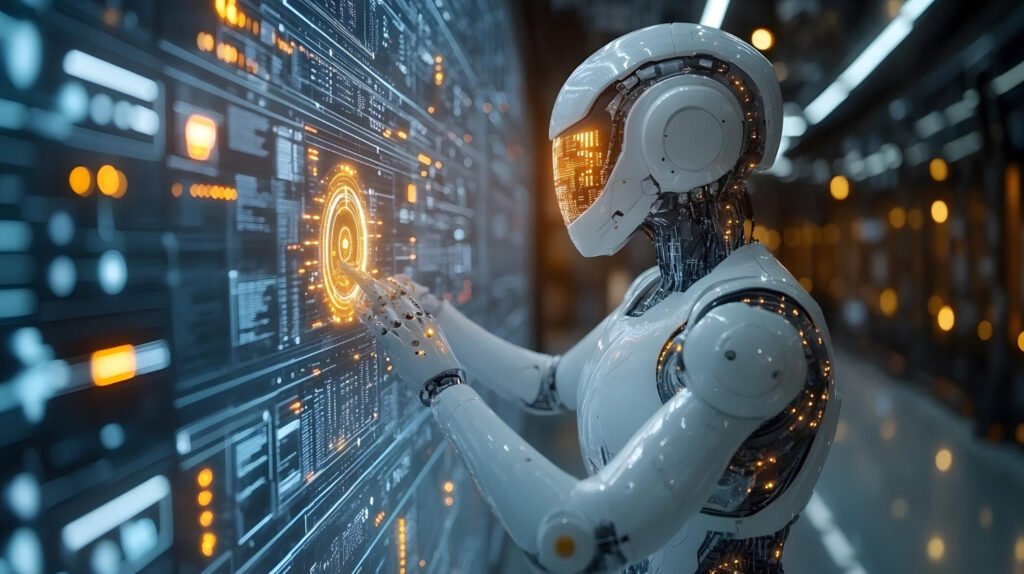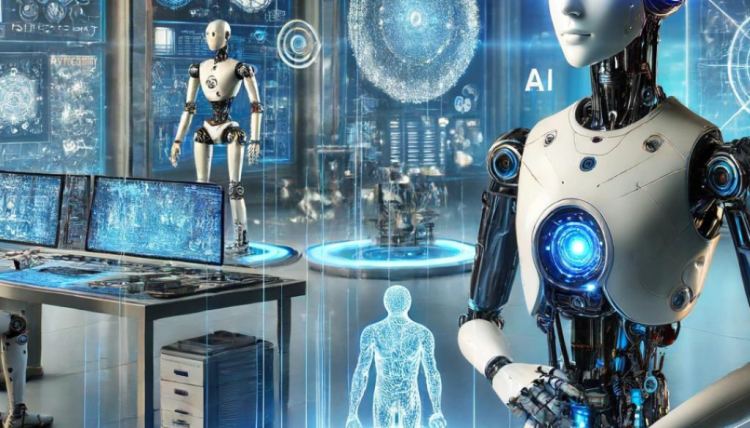Artificial intelligence (AI) has revolutionized the field of robotics by transforming machines from simple, pre-programmed devices into autonomous systems capable of learning, adapting, and making decisions. AI serves as the “brain” of modern robots, enabling them to perform complex tasks that once seemed exclusively within the human domain. The integration of AI into robotics has led to the development of robots that not only execute predefined actions but can also analyze their environment, understand context, and make independent decisions based on data input.
This article explores the pivotal role of AI in robotics, breaking down its contributions to enhancing the autonomy, adaptability, and intelligence of robots. We will also examine the key AI technologies driving this transformation, discuss their real-world applications, and explore the ethical and practical challenges of AI-enabled robots.
Introduction: The Role of AI in Robotics
In the past, robots were primarily mechanical devices designed to carry out specific tasks with high precision. These machines were limited by fixed programming and lacked the ability to adapt to new or unforeseen circumstances. Today, however, AI has fundamentally altered this landscape, enabling robots to learn from their environment, improve performance over time, and even make decisions autonomously.
AI empowers robots to interact with their surroundings in ways that were previously unimaginable. Whether it’s autonomous vehicles navigating city streets, industrial robots assembling intricate components, or service robots helping in healthcare, AI has become the cornerstone of modern robotics. Without AI, robots would remain limited to performing repetitive tasks without the ability to adapt to new information or unexpected changes.
The Key AI Technologies Empowering Robots
Several AI technologies play a vital role in enhancing the capabilities of robots. These technologies provide robots with the tools they need to process information, learn from experience, and interact with the world around them in intelligent ways.
1. Machine Learning (ML)
Machine learning is a subset of AI that enables robots to learn from data rather than following hardcoded instructions. Through ML, robots can be trained to perform tasks by feeding them large amounts of data, allowing them to identify patterns and make predictions or decisions based on new inputs.
- Supervised Learning: In supervised learning, robots are trained with labeled datasets (i.e., data that has been tagged with the correct answers). For example, a robot used in manufacturing might be trained to identify defective products by being shown examples of both defective and non-defective items. The robot learns to differentiate between the two by analyzing the patterns in the data.
- Unsupervised Learning: Unlike supervised learning, unsupervised learning involves training robots on data that is not labeled. Robots using unsupervised learning can group similar data together and detect patterns without needing predefined outcomes. This approach allows robots to recognize previously unseen situations and adapt accordingly.
- Reinforcement Learning: In reinforcement learning, robots learn by interacting with their environment and receiving feedback based on their actions. Positive outcomes (rewards) reinforce certain behaviors, while negative outcomes (punishments) discourage others. This method is particularly useful in autonomous systems such as drones or self-driving cars, where real-time decision-making is critical.
2. Computer Vision
Computer vision is the AI technology that enables robots to “see” and interpret visual information from the world around them. Through the use of cameras and advanced algorithms, robots can process images, recognize objects, and make decisions based on visual input.
- Object Recognition: By analyzing visual data, robots can identify and track objects in their environment. In a warehouse setting, for instance, robots equipped with computer vision can identify the location of specific items and navigate to them with precision.
- Depth Perception and 3D Imaging: Robots can also use computer vision to understand spatial relationships between objects. Technologies like stereo vision and LiDAR (Light Detection and Ranging) provide robots with depth perception, allowing them to navigate complex environments without colliding with obstacles.
- Facial Recognition: In service or healthcare robots, AI-powered facial recognition allows robots to identify and interact with humans on a more personalized level. This technology can also be used for security purposes, such as identifying authorized personnel in restricted areas.
3. Natural Language Processing (NLP)
Natural Language Processing (NLP) enables robots to understand, interpret, and respond to human language. Through NLP, robots can communicate with humans, process verbal commands, and even understand context and emotions in language.
- Speech Recognition: Robots can interpret spoken language and respond appropriately. Virtual assistants like Amazon Alexa or Apple Siri use NLP to process voice commands and perform tasks such as controlling smart devices or providing information.
- Contextual Understanding: Advanced NLP algorithms help robots to comprehend not just the words they hear, but the context in which they are spoken. For example, in customer service applications, robots can understand not just the specific words in a query but also the underlying intent, enabling more natural interactions.
4. Autonomous Navigation and Decision-Making
AI-powered robots are able to make real-time decisions by processing data from their environment and adjusting their actions accordingly. Autonomous robots, such as self-driving cars, use AI algorithms to navigate, avoid obstacles, and make decisions about speed, direction, and route based on dynamic environmental factors.
- Simultaneous Localization and Mapping (SLAM): SLAM algorithms allow robots to map unknown environments while simultaneously tracking their own location within the map. This capability is crucial for autonomous vehicles and delivery robots that must operate in real-time and in unpredictable environments.
- Path Planning: AI algorithms enable robots to plan efficient paths from one location to another, avoiding obstacles and minimizing travel time. This is essential for mobile robots used in warehouse automation or outdoor drones, where rapid and accurate decision-making is vital.

Real-World Applications of AI in Robotics
AI has facilitated significant breakthroughs in a variety of industries. By making robots more intelligent and autonomous, AI is enabling robots to take on increasingly complex tasks and contribute to solving some of society’s most pressing challenges.
1. Manufacturing and Industrial Automation
In manufacturing, AI-powered robots are transforming production lines by improving efficiency, reducing errors, and optimizing workflows. Robots equipped with AI can adapt to changes in production schedules, recognize defective parts, and even predict when maintenance is required to prevent downtime.
- Collaborative Robots (Cobots): Cobots, which work alongside human operators, use AI to safely interact with workers and assist with tasks like assembly, packaging, and quality control. These robots can adjust their actions based on human input and the environment, enhancing productivity while ensuring safety.
2. Healthcare Robotics
AI-powered robots are making significant strides in the healthcare sector, from performing surgeries to assisting with rehabilitation.
- Surgical Robots: AI-enabled surgical robots like the Da Vinci Surgical System assist surgeons in performing minimally invasive procedures with enhanced precision and flexibility. These robots analyze patient data in real-time, helping to make decisions during surgery and improving patient outcomes.
- Robotic Caregivers: In elderly care, AI-powered robots assist with daily tasks such as mobility, medication reminders, and emotional support. These robots can recognize and respond to the needs of elderly patients, improving their quality of life while alleviating the burden on caregivers.
3. Autonomous Vehicles
The development of autonomous vehicles, including cars, trucks, and drones, is perhaps one of the most exciting applications of AI in robotics. AI enables these vehicles to understand their environment, make decisions about route optimization, avoid collisions, and even predict and respond to the behavior of pedestrians and other drivers.
- Self-Driving Cars: Companies like Tesla, Waymo, and Uber are at the forefront of developing self-driving cars. AI allows these vehicles to navigate complex traffic systems, identify road hazards, and make split-second decisions that are crucial for safety.
- Delivery Robots and Drones: In logistics, AI-powered robots and drones are transforming the way goods are delivered. These robots can autonomously navigate urban environments, deliver packages, and even optimize delivery routes based on traffic conditions.
4. Service Robotics
AI is also driving advancements in service robots, which are being used in retail, hospitality, and customer service.
- Robotic Waiters and Bartenders: In the hospitality industry, robots powered by AI are being used to take orders, serve food and beverages, and clean tables. These robots are able to interact with customers, process requests, and adapt to changing customer demands in real-time.
- Retail Assistance: In retail, AI robots can assist customers by answering questions, helping them find products, and providing personalized recommendations based on customer preferences and browsing history.
Challenges and Ethical Considerations
Despite the transformative potential of AI in robotics, there are several challenges and ethical issues that need to be addressed as these technologies continue to develop.
1. Job Displacement and Automation
As robots take on more complex tasks, there is growing concern about job displacement. Automation, fueled by AI, has the potential to replace human workers in industries like manufacturing, logistics, and customer service. While AI can improve efficiency, it is essential to consider the social and economic impacts of this technological shift and find ways to retrain workers for new roles in the workforce.
2. Ethical Decision-Making
AI-powered robots, especially in areas like healthcare and autonomous vehicles, may face situations where they must make ethical decisions. For example, a self-driving car might have to decide between two potential outcomes, one of which involves harm to a human. Programming robots to make ethical decisions that align with societal values is a complex challenge that requires ongoing research and dialogue.
3. Data Privacy and Security
AI systems rely on vast amounts of data to function, raising concerns about data privacy and security. Robots equipped with AI often collect sensitive information, whether it’s through sensors, cameras, or interaction with humans. Ensuring that this data is protected and used ethically is essential to prevent misuse and violations of privacy.
Conclusion: The Future of AI in Robotics
Artificial intelligence is undoubtedly one of the most powerful enablers of robotics today. By making robots smarter, more autonomous, and capable of understanding complex tasks, AI has expanded the scope of what robots can achieve. From manufacturing to healthcare, autonomous vehicles to service robots, AI is making a profound impact across industries.
However, as AI continues to evolve and become more integrated into our daily lives, it is crucial to address the ethical, social, and practical challenges that accompany these advancements. By balancing innovation with responsibility, we can harness the full potential of AI in robotics, ensuring that these technologies enhance human capabilities and improve the quality of life for people around the world.











































